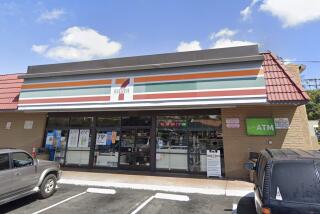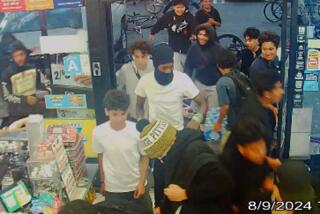Dangerous Hours : Retail: All-night convenience store chains interview robbers, turn up lights and install cameras to deter crime. Some O.C. franchisees say itâs not enough.
ANAHEIM â Manmeet Nijjar has all the latest crime-prevention gear in place at his 7-Eleven store, and he and his employees have learned the latest policies and theories on criminal behavior.
*
There are more and brighter lights inside and out. Windows are uncluttered for a better view. Aisles are wider and better marked so customers can get what they want quickly. No more than $30 in cash is kept in the till at night. New audio-video cameras and color monitors make it obvious that everyone is being filmed.
But he knows that incidents like the early-morning killing last week of 7-Eleven clerk Nirmal Singh in La Habra during a robbery can happen anywhere, any time.
âIt tells you how your life can change at any second. It tells you how life can be unpredictable,â Nijjar said. âIâve been in business 12 years and never had a serious problem. But the next minute, it could change.â
It is that increasing chance of random violence, as much as the anxious moments operating a store in a high-crime area in the wee hours of the morning, that is causing some franchise owners to say that 7-Eleven parent company Southland Corp. isnât doing enough.
âThey believe that if they put in significant lighting and security cameras, that will resolve the matter,â said San Diego franchisee Jim Alberts. âMost stores already had security cameras and that doesnât solve the problem. Thereâs a lot of random criminal activity. In these changing times, you have to take drastic steps.â
For Alberts, the most important thing Southland could do is give franchisees the option of closing after 11 p.m., something the Dallas company hasnât allowed at its 5,600 U.S. stores since 1971.
Those who buy 7-Eleven franchises know that they are expected to keep the stores open all day and all night, according to their contracts. Thatâs what the franchise is all about, and Southland wonât stand for anything less.
âItâs the cornerstone of our business,â said Southland spokeswoman Margaret Chabris. âThatâs what customers expect of us.â
*
A small group of franchisees, led by Alberts, sued Southland two years ago in a complex $100-million class-action and antitrust suit that, in part, seeks to undo the requirement for 24-hour operations.
Alberts has noted previously that five of six 7-Eleven employees shot to death in California from 1990 to 1993 were killed in robberies from 11 p.m. to 5 a.m. In addition, seven of 10 workers critically injured in those years were hurt during those same late hours.
Franchisees can close at night without Southlandâs consent, but they incur a hefty penalty. The company has a right to take up to 6% more in gross profits or even, Alberts said, take over the store.
By contrast, the AM/PM Mini Markets chain gives operators the option of closing late at night, though it requires a payment of 3% more from revenue, said Scott Loll, a spokesman with parent company Atlantic Richfield Co. in Los Angeles.
In one Portland, Ore., case, Loll said, crime was such a problem that AM/PM closed the franchiseeâs store and gave him a company outlet elsewhere. Chabris, pointing out Southlandâs effort to select good locations, said criminal activity hasnât yet forced the company to shut a 7-Eleven store.
Alberts, who formed the 7-Eleven Owners for Fair Franchising in 1991 to handle disputes with Southland, has been agitating for legislation that would force changes in the franchise contracts. So far, though, he hasnât received responses from government officials.
His groupâs lawsuit, pending in Alameda County Superior Court, is described by lawyers on both sides as one based more on monetary concerns. The suitâs primary focus is on credits, rebates and allowances the franchisees say Southland owes them.
Some Orange County 7-Eleven operators were disgruntled about Southlandâs security efforts, but they refused to discuss their disagreements or divulge their names. âTheyâre never going to help. Itâs very bad,â said one Anaheim franchisee. âWeâre in such a position, we canât do anything.â
Another Anaheim operator, however, was more philosophical. âHow can you deter crime?â said franchisee John Abboud. âItâs here. Regardless of whoâs to blame, society has to deal with it.â
*
The mandate to stay open has forced Southland to become a major developer of crime prevention techniques, using research studies and their own ingenuity to come up with their strategies.
More than 100 of the chainâs 5,600 stores nationwide, for instance, still pipe classical music inside and outside their stores to dissuade teen-agers from loitering, a plan Canadian managers devised years ago when they realized troublemakers didnât like Bach or Beethoven. In other areas, Barry Manilow songs or country-Western tunes drive loiterers away.
Since 1975, Southland has joined with various research groups to study criminal behavior and test ideas to deter robberies. Under a U.S. Justice Department grant, it joined with the Western Behavioral Sciences Institute to talk with convicted robbers, develop deterrents and test them at 7-Eleven stores. Robberies fell 30% during six months at the stores tested.
About two years ago, Southland began remodeling its stores in a format designed to deter crime. Manmeet Nijjarâs store, for instance, was changed over to the new system last year, and he said that he and his employees feel safer.
The AM/PM Mini Markets chain also has been taking similar measures to beef up security so they can continue to operate 24 hours a day.
Convenience stores recognize the trade-off. Two-thirds of the crime at the 24-hour operations occur in the early morning hours. Store owners realize they have to be at the forefront of crime prevention to reap the profits that such hours provide.
Despite calls for even greater safety measures following last weekâs shooting in La Habra, clerks arenât likely to don flak jackets soon or sit behind bullet-resistant glass. Itâs not customer-friendly, nor is it practical, experts say.
âThe customer is saying, âWhy am I out here and you are in there,â â said Lindsay Hutter, a Seattle researcher. âThese stores are trying to prevent crime in general.â
*
Arcoâs Scott Loll points out that such drastic measures could backfire and that police often donât approve of glass cages in particular because they cause other problems. âRobbers have simply held customers at risk,â he said.
Over the years, Southland, AM/PM and others have continued to talk to convicted robbers to determine what they look for.
Southland found, for instance, that bandits first consider how much cash might be on hand and how well the cash register and the clerk are hidden from view. It created a list of such items and instituted policies--such as limiting the amount of cash on hand and increasing visibility by clearing clutter from windows--to counter each one.
âThe first thing you have to do is to make the store as unappealing as possible to the perpetrator,â Loll said. âWe believe, based on research and study and on consultation with the crooks themselves, that lighting is the single biggest deterrent.â
Both AM/PM and 7-Eleven have been upgrading the lighting at their stores, as well as adding extensive audio and video monitoring systems. They also have been training their clerks, delivering a clear message: Donât resist under any circumstances.
All of that, though, didnât help Nirmal Singh. The La Habra store he was working in at 3 a.m. had been remodeled only a month earlier in mid-July. He gave no resistance to two robbers who came in and gunned him down for no apparent reason.
âWhat happened in this store is an anomaly,â Chabris said. âNo matter what people try to do to harden themselves as targets, there are other people who have no regard for human life.â
(BEGIN TEXT OF INFOBOX / INFOGRAPHIC)
Hazardous Duty
Most convenience store homicides occur from 11 p.m. to 7 a.m., according to a nationwide study conducted in 1991, the most recent available. Homicides by shift.
Shift
Night (11 p.m-7 a.m.): 54 (69%)
Evening (3-11 p.m.): 16 (20%)
Day (7 a.m.-3 p.m.): 9 (11%)
What Attracts Thieves
A 1986 study asked 181 convicted armed robbers to rate 11 factors as to how important each was in deciding which store to rob. Here are their rankings of target attractiveness, rated from 1 to 5, with 1 being most important: *--*
Factor Average rating 1. Amount of money 1.27 2. Escape route 2.33 3. Anonymity 2.76 4. Interference 3.02 5. Active police patrol 3.44 6. Armed clerk 3.60 7. Number of clerks 3.76 8. Number of customers 3.80 9. Camera system 4.18 10. Alarm system 4.39 11. Video recording system 4.79
*--*
Convenience Store Crime
Convenience store numbers nationwide and the rate at which they were robbed declined in 1993, the most recent year for which data is available. But the homicide rate and the average loss both increased: *--*
CONVENIENCE STORES ROBBERIES* HOMICIDES* 1989 35,701 317 1.05 1990 36,011 312 1.37 1991 33,806 380 0.95 1992 34,108 315 0.88 1993 33,440 288 1.43
*--*
* Per 1,000 stores
Source: Athena Research Assn., National Assn. of Convenience Stores; Researched by JANICE L. JONES / Los Angeles Times
More to Read
Inside the business of entertainment
The Wide Shot brings you news, analysis and insights on everything from streaming wars to production â and what it all means for the future.
You may occasionally receive promotional content from the Los Angeles Times.










